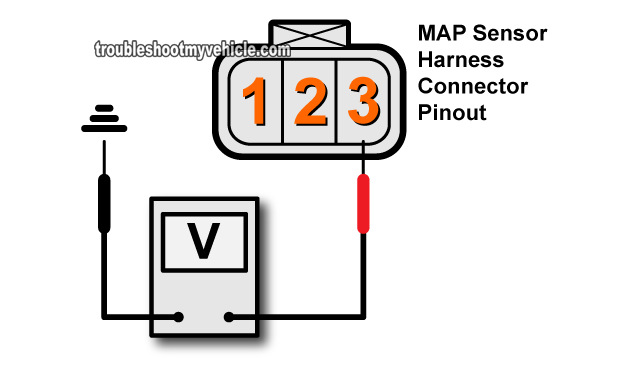TEST 2: Checking That The MAP Sensor Is Getting Power

If in TEST 1 your Nissan Pathfinder's MAP sensor did not create a signal then there's a good chance that the sensor is missing either power or Ground.
So the next step is to verify that the MAP sensor is getting 5 Volts on terminal number 3 of its harness connector (see illustration above).
This is what you'll need to do:
- 1
Place your multimeter in Volts DC mode.
- 2
Connect the red multimeter test lead to the wire that connects to the female terminal labeled with the number 3.
Avoid probing the front of the connector to avoid damaging the female metal terminal.
The best way to get to the Signal inside the wire is using a wire piercing probe. You can see an example of this tool here: Wire-Piercing Probe. - 3
Ground the black multimeter test lead directly on the battery negative (-) terminal.
- 4
Turn the key to the ON position (but don't start the engine).
If all is OK, your multimeter should read 4.5 to 5 Volts DC.
Let's take a look at your test results:
CASE 1: 4.5 to 5 Volts are present- So far so good, since this means that the PCM is supplying power to the manifold absolute pressure (MAP) sensor.
The next step is to make sure that the PCM is feeding your Nissan's MAP sensor with Ground. For this test, go to: TEST 3: Verifying The MAP Sensor Is Getting Ground.
CASE 2: 4.5 to 5 Volts ARE NOT present. Recheck your multimeter connections and retest.
If after checking all of your multimeter connections and making sure the key is in the ON position AND your multimeter does not register the 4.5 to 5 Volts DC, then you've found the reason for the MAP sensor code/failure.
Without power in this circuit, the MAP sensor will not work. Now, it's beyond the scope of this article to test for this missing Voltage, but the most likely cause will be an open-circuit problem between the PCM connector and the MAP sensor connector.
TEST 3: Verifying The MAP Sensor Is Getting Ground

So far you've verified two important things about your Nissan's MAP sensor:
One: The MAP sensor is NOT producing a signal TEST 1.
Two: That it's getting power on terminal number 3 of the harness connector (TEST 2).
The next step is to check that terminal number 1 of the sensor's harness connector is feeding the MAP sensor Ground.
IMPORTANT: The PCM is the one that provides this Ground internally, so be careful and don't intentionally or accidentally short this wire to battery voltage or you'll fry the PCM.
This is what you'll need to do:
- 1
Place your multimeter in Volts DC mode.
- 2
Connec the black multimeter test lead to the wire that connects to the female terminal labeled with the number 1 of the MAP sensor's harness connector.
Avoid probing the front of the connector to avoid damaging the female metal terminal.
The best way to get to the signal inside the wire is using a wire piercing probe. You can see an example of this tool here: Wire-Piercing Probe. - 3
Connect the red multimeter test lead directly to the battery's positive (+) terminal.
- 4
Turn the key to the ON position (but don't start the engine).
If all is OK, your multimeter should read 10 to 12 Volts DC.
Let's take a look at your test results:
CASE 1: Your multimeter showed battery voltage- So far so good, since this means that the PCM is supplying power to the manifold absolute pressure (MAP) sensor.
This confirms that the manifold absolute pressure (MAP) sensor is bad and needs to be replaced. Why? Well, because so far you have confirmed that:
- The MAP sensor is not producing a signal when vacuum is applied to it (TEST 1).
- The MAP sensor is getting its 5 Volts (TEST 2).
- In this test step, you've confirmed that the MAP sensor is getting Ground.
Taking all of these 3 test results you can conclude with confidence that you need to replace the MAP sensor with a new one.
CASE 2: Your multimeter did NOT show battery voltage. Recheck your multimeter connections and retest.
If after checking all of your multimeter connections and making sure the key is in the ON position AND your multimeter does not register the 10 to 12 Volts DC, then you've found the reason for the MAP sensor code/failure.
Without Ground in this circuit, the MAP sensor will not work. Now, it's beyond the scope of this article to test for this missing Ground, but the most likely cause will be an ‘open’ between the PCM connector and the MAP sensor connector.
More 3.3L Nissan Test Tutorials
You can find a complete list of tutorials here: Index of Nissan 3.3L Articles.
Here's a sample of the tutorials you'll find in the index:
- MAP/BARO Pressure Solenoid Test (1996-2004 3.3L Pathfinder).
- P0130, P0150 Front O2 Sensor Tests (1996-2000 3.3L Nissan Pathfinder).
- Throttle Position Sensor Test (Nissan 3.3L Pathfinder, Xterra, Frontier).
- How To Troubleshoot A No Start (Nissan 3.0L, 3.3L, 3.5L).
- How To Test Engine Compression (Nissan 3.0L, 3.3L, 3.5L).

If this info saved the day, buy me a beer!


